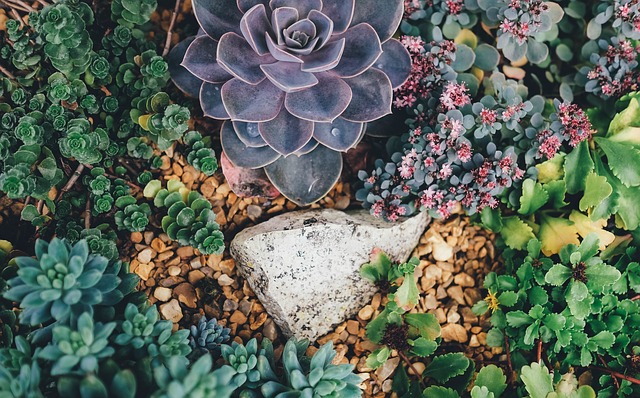
How To Grow Succulent Plants
This is an introduction on a diverse and very interesting group of plants. How to grow succulent plants will guide you through what may become a lifelong addiction to this superb and highly adaptable species.
Succulents are plants that store water. They grow in arid climates or arid soil conditions in areas that have little or no rainfall. They conserve water in their thick fleshy leaves or stems.
They will survive on low water levels by taking moisture from dew and mist.
Some varieties will store moisture in their roots which mean in extreme circumstances they die right back below the soil surface but will still survive. They wait for more favourable conditions for them to grow again.
They can endure extended drought periods which in these worrying times of climate change and drier seasons in some parts of the world means they are an important plant to have.
Their ability to survive in these water limited ecosystems make them an unusual and very interesting plant to grow.
These highly decorative plants are widely popular with enthusiasts for their strikingly diverse shapes and colours, some of the larger varieties such as Aloes, Agave or Yucca are a great focal point of interest and ideal for Mediterranean or desert style gardens.
Garden and interior designers love using them as they add a bold, architectural statement to modern and contemporary schemes.


Many succulents have medicinal properties, probably one of the most well-known examples is Aloe vera, used in skin care creams, cleansing lotions and supplements.
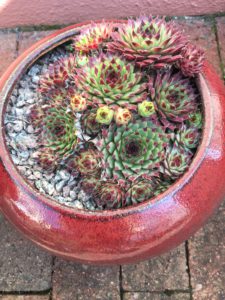
How To Grow Succulent Plants In Your Garden
I recently wrote a blog on low maintenance gardens… well, Succulents are another great plant for busy people who want to enjoy their beautiful outdoor spaces but don’t always have much time for doing any maintenance. Easy Low Maintenance Garden Ideas
As well as being low maintenance with few demands succulents are pretty and unusual. They’re one of the oddballs of the horticultural world thereby providing more wow factor to your garden.
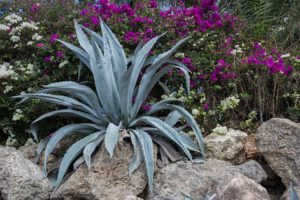
A cold and wet winter can be particularly destructive for succulents therefore, container planting is one of the easiest ways to grow them as you can provide the exact conditions required in terms of soil, nutrients, water, drainage and place them in the sunniest part of your garden. ideas-for-spring-containers
There is a huge array of shapes, colours, sizes and textures available for you to play around with whilst still ensuring their survival.
When the weather becomes too unkind for them, the containers can be brought indoors.
To start with something easy and reliable I recommend you plant Sedums and Sempervivums. These are amongst the hardiest of succulents and can survive a winter outdoors if they are protected from the frost and wet. They are lovely for enthusing children with a plant of their own to care for. gardening-ideas-for-children
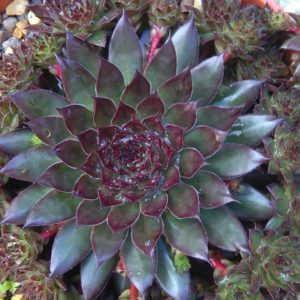
The above photo is used with the kind permission of Andy @APezza8
Sempervivums are commonly known as hen-and-chicks. This cute name comes from the way the parent plant grows a huddle of smaller baby plants around it.
These are easily propagated –
Gently remove them from the parent plant.
Pot them up in a low nutrient soil with added grit and water well.
Pop them somewhere with plenty of light and sunshine.

Once you become sure of being able to look after these you could then try your hand at the more unusual succulents like Pachyphytm, Aeonium or Echeveria. These plants thrive outside during the summer but require some winter protection.
If you don’t have a frost-free greenhouse then simply bring them inside and treat them as a houseplant during the colder months.


Growing Succulents Indoors
Succulents are a wonderful choice of interior plant.
Easy to grow? Well, yes they are if you can provide desert conditions.
As with any plant they require the correct growing conditions.
Providing the correct light levels for any plant can be a challenge, this is tenfold for succulents as they are used to desert conditions with unrelenting hot sun for about 12 hours a day. Emulating that is not an easy task.
All you can do is place your succulents in the sunniest south facing window.
Soil needs to be low in nutrients with grit or perlite added to it.
John Innes 2 is the recommended growing medium to use.
As with any plant, give them space…
Succulents tend to come packed into small pots or bowls, crammed together. There aren’t many plants that will survive such cavalier treatment, succulents included.
This overcrowding of plants can cause disease, mould and infestations of mites/insects all of which are detrimental to a succulents health.
Separate the plants and give them more space, preferably in their own containers so that they can obtain all the nutrients and water that they need without having to compete with others for it.
Watering
Even though they are desert plants, they still require a good dousing with water.
When the soil is dry, give them a good amount of water, until it is running out of the drainage holes, then do not water until the soil is dry again. If you imagine being in the desert, a downpour of rain occasionally is what these plants thrive on.
The gasteria photo below is used with the kind permission of Andy @APezza8

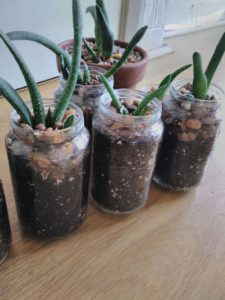
Succulents For Green Roofs
A green roof or a living roof is a building roof that is planted with greenery over a waterproof membrane.
Systems complete with drainage, root barriers and irrigation can be bought and installed but it is also quite straightforward to make your own system if you’re handy with DIY. Be sure to install a waterproof membrane to protect the roof and add really good drainage.
Sempervivum and Sedum are ideal plants for a green roof as they need very little care and attention. easy-low-maintenance-garden-ideas
The benefits of a green roof are numerous
- Absorb rainwater
- Provide Insulation
- Wildlife Habitat
- Decreases Stress levels of people around it
- Lowers air temperature
- Low maintenance
- Aesthetically pleasing
How To Make a Succulent Tower
A plant tower offers a perfect solution to using old terracotta pots. It doesn’t matter if they are chipped or otherwise slightly damaged.
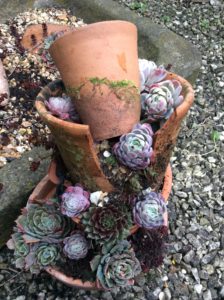
It is an attractive and unusual way of displaying garden succulents such as Sempervivums, Sedums and Echeveria. You can make it as small or as tall as you wish.
Making a succulent tower is also a fun project to encourage children to take an interest in gardening.
You will need
- At least 3 terracotta pots of decreasing size
- A cane
- Compost
- Fine grit or perlite
- Decorative grit
- A selection of succulents as mentioned above
Fill each pot half-way with fine grit or gravel then stack the pots in order of size, starting with the largest.
Push the cane through the drainage hole in each pot to stabilise the tower.
Top up the pots with a mix of compost and grit, then plant your selection of succulents, back fill gaps with the compost mix and firm in the plants.
Any gaps that are still left, fill with decorative grit.
Water well.
Other plants that are ideal for a pot tower are Alpines, kitchen herbs or strawberries. gardening-ideas-for-children
Quirky Plants
So in conclusion if you want something quirky and eye-catching, that is a bit different from the norm then start growing these wonderfully eccentric plants.
Be warned they are quite addictive but I have to say where I live they are hard to come by. There are 3 large garden centres within a few miles of me, none of which stock them. I can however order them online and/or propagate my own. Find a good choice of succulent plants here

@APezza8
I hope that you have found this article useful, please share with friends, family and on social media, lets grow the love of plants and gardening.
If you have any questions or views on succulent plants please pop them in the comments box below, I love to hear from you and I always reply as soon as possible.
Happy Gardening


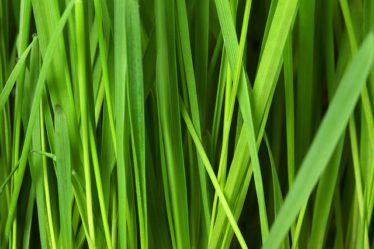
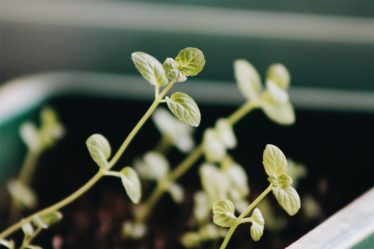

What a beautiful article. I love plants and especially the one you are talking about are so popular where I live. In the canary islands, near the coast of Africa, Aloe for example it’s really a famous plant and so good for the body with so many different properties. Unfortanately for as much as I love thme I alwasy worried I might not be good enough to make them grow but after reading your post I kind of have a boost of confidence and might actually try. Thank you so much
Hi Barbara,
I used to live on Lanzarote and I have seen also the Aloe plant farms on Tenerife.
Succulents are terrific plants, I do hope you have a go at growing them, the climate in the Canary Islands is perfect for them. Don’t hesitate to contact me if you would like further help or advice for growing them.
info@plantsbulbsseeds.com or leave a comment here.
Thank you so much for your comments
Louise
This is interesting with lots of valuable information.
I just learned that succulents need lots of sunlight even if they are indoors. Maybe that’s why when I buy a cactus they don’t survive very long.
They are actually expensive, too so I buy the very small ones.
I’ll try to buy again and follow your instructions on caring for them.
Thanks,
Marita
Hi Marita,
Thank you for your comments.
Yes cacti do like lots of sunshine, even indoors, so if you buy anymore find them a sunny windowsill to live on.
All the best
Louise
Thanks for this great post on succulent plants. My favorite succulents hands down are Aloes. They are easy to grow, they offer so many incredible benefits and they are beautiful, especially when they are flowering. We have loads of Aloes in our garden and it is so super handy to have them. I use Aloes for so many things from burns to using it for detoxing in detox drinks and in my smoothies. When my children were babies I would use it for their diaper rashes – best remedy ever!
I love how easy they are to maintain and since they are water wise I don’t have to worry about watering them. I should really consider growing more succulents.
Hello Lynne, thank you for your comments.
Aloes are marvellous aren’t they, so many benefits and remedies. I’ve never tasted an aloe smoothie though,that is certainly different.
All the best
Louise
Good evening Louise,
I really enjoyed your post on How to grow succulent plants. I live in the south of Spain and have quite a nice collection on my patio. When the many Aeonium get too high I cut them, take out the in-between part away and replant the head. That functions beautifully.
I like your plant tower, that is something I should try. Nearly every year I give my plants new soil, they love it and say thank you with beautiful flowers.
Regards, Taetske
Hi Taetske,
Thankyou for your comments,
Your plants must love your patio in Spain, probably your succulents can stay outdoors throughout the year. Some of them here in the UK have to be protected from frost.
They propagate so easily, as you know.
I love the Aeoniums.
Best Wishes
Louise
Actually I haven’t tried this plants before, I always see them in my neighbour’s garden here in canary Island. I love their colours but unfortunately for as much as i love them i always wonder if i will be good enough to make them grow but i think after readig this post, i will have to give it a try with an 80% confidence.
Hi,
I hope you do have a go, they’re lovely plants to have.
Hi Louise, I love your articles. I grew up in New York City with no gardens at all. Fell in love with a farm girl, who I have to go out drag her in from her gardens. I do help and I feel really appreciative being out in the sunshine with nature and feeling better afterwards. I’m leaning, but I have a long way to go.
I will be visiting your site often through the summer.
Do you have any posts for super slow beginners?
Hello Ed,
Thank you for your comments,
Lol, yes it’s difficult sometimes to get a gardener in from their garden. Gardening certainly helps you feel better and healthier.
You’re welcome to visit my website anytime
Have patience with learning,ask your lovely girl for some easy planting/growing jobs.
Further reading…Ideas for Spring Containers
Clematis …How to Grow
How to Grow Plants From Seeds. 5 Easy Steps
Gardening for Well-being, Why Gardening is Good for your Health.
Hope these help
Louise
Hey very nice content with such beautiful colours and I love it. I’m a fan of nature and it always amazed me to see a different plant that I’ve never seen before.like aloe flower my question is do they taste bitter like the aloe Vera plant ? Just curious on that one. I’m sure you will get attention for the ones who’s doesn’t have time to do the maintainance with their gardens. I love what your doing so keep up the good work an beauty. 🙂
Hello,
Thank you for taking time to comment.
In answer to your question, the flowers are edible and used as a veg and in medicines , however I have never eaten them but if they are eaten as veg they can’t be too bitter.
Best wishes
Louise
Great article. I am not a plant person in my family My wife has the green thumb and she can certainly crate a lovely summer garden or flower bed. I do have to admit, that these are some really pretty flowers that I may be able to keep alive for an extended period of time. I will make sure I refer my wife to your site. She will love to read it. Thanks for the article.
Hello Doug, Thankyou for your kind comments and for referring my website to your wife, I hope she enjoys reading and yes do have a go at growing these wonderful plants…you never know you may catch the gardening bug!
All the best
Louise
What a lovely article that should encourage even the most wary to start looking after plants. I remember my mother had a row of succulents on our conservatory shelf, which seemed ideal for them: hot when the sun was out, but protected from the winter damp. I can vouch for aloe vera: I bought my wife one when we were in England, and it was already sprouting little ones before we came to North-West Spain. Now we have separated the offspring into five different pots! Agave grows wild here (Galicia), despite the winter rain, and is so successful that it is classed as a non-native pest species! I’ve also seen it flowering spectacularly in Devon and Cornwall: the flower spike can reach ten feet and more! But the smaller succulents are indeed easy to grow and satisfying to just have around as a continuing other live presence in a room; and they tolerate central heating more easily than some leafier indoor plants.
Your header picture shows how it’s possible to mix different succulents with some artistry (we have a mixed succulent “grotto” in a space in our courtyard wall) and should inspire readers to have a go themselves. These forgiving plants really are easy to maintain.
Hello,
Thank you so much for your comments. It’s lovely to hear about your garden in Spain and how well your plants are doing.
Agave does indeed grow well in Devon and Cornwall, I live in Devon and many public gardens feature them.
St Michael’s Mount in Cornwall also has some great specimens, which is testament to how easily they adapt to their surroundings. The Scilly Isle gardens have them too.
Thankyou for enjoying my article.
Best Wishes
Louise